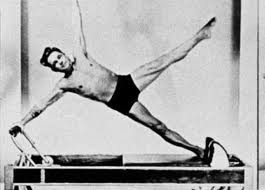 The first "exercise" a new client learns when working on the Reformer is how to sit from standing, and then lie down with control and in the proper position. This first lesson begins a commitment to learning "transitions," or the movements that we make between the actual exercises we learn on the Pilates mat and apparatus. These transitions blend one exercise into the next to form a seamless workout. This is one of the unique properties of a True Pilates workout - one of the most important ways that we deepen our workouts into the realm of "artful" as well as mindful movement.
The first "exercise" a new client learns when working on the Reformer is how to sit from standing, and then lie down with control and in the proper position. This first lesson begins a commitment to learning "transitions," or the movements that we make between the actual exercises we learn on the Pilates mat and apparatus. These transitions blend one exercise into the next to form a seamless workout. This is one of the unique properties of a True Pilates workout - one of the most important ways that we deepen our workouts into the realm of "artful" as well as mindful movement.In Pilates we work towards achieving precision and flow. This begins by leaning to transition between exercises on the apparatus -- changing springs efficiently and properly so as not to waste time and energy and to keep the workout moving. We want to achieve a minimum of motion between the exercises to maximize the flow and movement of the complete workout!

Purpose of Transitions
The purpose of transitioning between exercises is to keep the workout moving - to get to that important "flow." In a Pilates workout, even the space between the exercises is exercise. Transitions intensify the workout, develop the flow, and keep you focused on what you're doing. Learning and using transitions moves your Pilates practice to a new level -- to the way that Joe intended -- to a full hour of mindful movement.
Benefits of Transitions
On the apparatus, when you move smoothly from one exercise to the next, (including changing springs, lowering the footbar, etc) you are essentially training yourself to workout without the help of an instructor. You are becoming self-aware and self-sufficent, and you can take the self-sufficent workout with you wherever you go. If you visit another studio, you will know exactly what to do and be "at home" with your Pilates practice.
Another great benefit of learning your transitions is that you will advance in the Pilates method more quickly. Smooth transitions save time, and you'd be surprised how much time is actually left in the hour when transitions are done correctly. That means more time to learn new exercises. In fact, you won't only advance by learning new exercises, but transitioning will put you so deep into "the zone" that your mental workout will advance as well.
 Examples of Transitions
Examples of Transitions-Changing springs on the reformer
-Getting on/off the Reformer, Long Box, Short Box and
Chairs, etc. properly
-Transitions between mat exercises
-Transitions between exercises in the Long Stretch Series,
Stomach Massage Series, etc.
-Lowering the Footbar on the reformer for an efficient
workout
-The transition from coming into the studio standing, to lying down, to standing again
So go for the flow! Work the transitions as if they are truly exercises themselves - to be understood and mastered. Your Pilates practice will be the better for it!
No comments:
Post a Comment